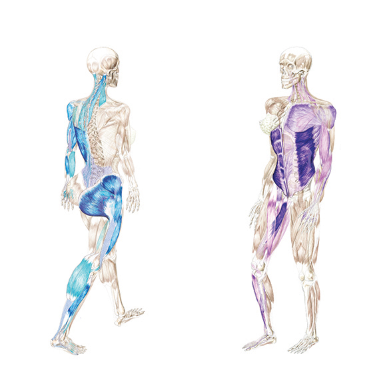The Fascial Sling System and Its Impact on Sports Performance and Fitness | The FIT Facility
The Fascial Sling System and Its Impact on Sports Performance and Fitness
The fascial sling system is one of the most important and yet often overlooked systems in the human body. It refers to a group of connective tissues called fascia that form a network of connective fibers that support and stabilize the body, acting as a sort of internal body suit. The different fascial sling systems are responsible for connecting the muscular chains that make up our limbs and torso, and they provide support to our joints, bones, and organs.
In the human body, there are several fascial sling systems, each responsible for a particular movement or action. The anterior sling, for example, connects the pectoral muscles to the hip flexors and is responsible for movements like walking, running, and jumping. The posterior sling, on the other hand, connects the back muscles (lats) to the glutes and is also most commonly seen in gait patterns.
Understanding the fascial sling systems is crucial for improving sports performance and fitness. By strengthening the muscles associated with each system and working to improve coordination between them, athletes can achieve greater stability, agility, and strength.
For example, athletes who participate in explosive sports like football, soccer, basketball or volleyball would benefit from training their anterior/posterior oblique sling system, which is responsible for rapid acceleration/deceleration and explosive movements. Exercises like squats variations, lunges, and plyometric training can help improve the strength and coordination of this system, allowing athletes to run faster, stop sooner.
Overall, the fascial sling system is a critical component of sports performance and fitness. By understanding and training these systems, athletes can improve their overall athletic ability, strength, and endurance, leading to better performance on and off the field.
The Fascial Sling Systems
The human body is more than just a collection of individual muscles and bones. Instead, it is a complex network of fascial sling systems that work together to produce movement and support the body's structures. There are four main fascial sling systems: the anterior oblique system, posterior oblique system, deep longitudinal system, and lateral subsystem.
The anterior oblique system includes the muscles of the hip, abdominal wall, and chest. These muscles work together in a diagonal pattern (serape effect) to provide stability and power during movements such as running, jumping, and throwing. By training these muscles specifically, athletes can improve their performance in these types of explosive movements.
The posterior oblique system involves the glutes and opposite-side latissimus dorsi muscle, as well as other muscles in the lower back and hip. This system functions by producing rotational force in movements such as twisting, turning, and changing direction. Strengthening these muscles through exercises such as lunges and squat/hinging variations can improve an athlete's agility and overall athletic performance.
The deep longitudinal system includes the muscles that run along the back of the body, including the erector spinae muscles and the gastrocnemius muscle (calf). These muscles work together to provide stability and support in activities such as running and jumping. By training these muscles through exercises such as planks, squats, etc., athletes can improve their stability and prevent injuries.
The lateral subsystem includes muscles such as the gluteus medius, tensor fascia latae, and adductors. This system works to stabilize the hip and pelvis during movements such as walking, running, and jumping. Training these muscles through exercises such as step-up and their many variations as well as single leg squats, can improve an athlete's balance and prevent the risk of injury.
Overall, understanding the fascial sling systems and training them specifically can have a significant impact on sports performance and fitness. By targeting these muscles through exercises that reflect their movements and functions, athletes can improve their strength, power, stability, and overall athletic performance.
For more information on our Sports Performance Program for middle school/high school aged athletes clink here.
For more information on our Total Fitness Program, click here.


